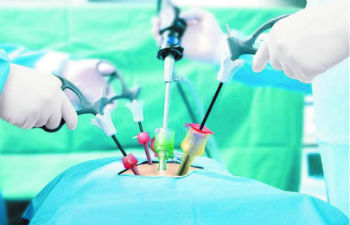
Laparoscopic surgery, also called key hole surgery is a minimal invasive surgical technique that both provides a panoramic & magnified view of the pelvic organs and allows surgery at the time of diagnosis.
The main advantages are:
- Less post-operative pain
- Small incisions
- Faster recovery
- Lesser adhesions formation in the abdomen
- Quick return to normal activity
Procedures done
- Diagnostic laparoscopy
- Operative laparoscopy:
- Hysterectomy
- Ectopic pregnancy
- Endometriosis
- Ovarian cysts
- Tubal surgeries
- Myomectomy
- Sling operations for prolapse
- Laparoscopic application of cervical cerclage
Diagnostic Laparoscopy
Laparoscopy has become one of the main investigative modalities in Infertility, specially in the evaluation of uterus, ovaries, tubo-ovarian architecture, status of the fallopian tubes. It further helps in assessment of peritoneal surfaces for presence of endometriotic lesions. Also laparoscopy helps in evaluation of Chronic Pelvic Pain.
Operative Laparoscopy
- Hysterectomy – Laparoscopic hysterectomy involves removal of the uterus. Performed using minimally invasive laparoscopic surgical techniques, this procedure reduces the length of surgery, hospital stay and recovery time — as well as pain and complications. Laparoscopic hysterectomy is associated with less intraoperative blood loss as well. Complicated cases with large uterus, multiple fibroids, in patients with previous caesarean section or associated with endometriosis and adhesions are also dealt with laparoscopically.
- Ectopic pregnancy – An ectopic pregnancy is when a fertilised egg implants itself outside the uterus, usually in one of the fallopian tubes. Salpingostomy or salpingectomy can be performed laparoscopically. The correct operative procedure depends on the location of the pregnancy and the desire for future fertility.
- Endometriosis – is a disease process that affects women mainly in their reproductive years. Endometrium, the normal lining of the uterine cavity, its foci are seen in sites of the body other than the uterus – usually within the pelvis. Advanced laparoscopic surgery, with great precision, is done to dissect and excise endometriotic lesions. This restores fertility and helps in long-term pain relief.
- Ovarian cysts – Large or persistent ovarian cysts, or cysts that are causing symptoms, usually need to be surgically removed. Surgery is also normally recommended if there are concerns that the cyst could be malignant or could have complications like torsion.
- Tubal surgeries – Tubal procedures done commonly include
- Tubal sterilization – for couples planning permanent method of sterilization. Laparoscopic tubal sterilization is done by either using bipolar electrosurgery, clips or silastic bands.
- Tubal clipping for patients with hydrosalpinx and planning pregnancy. Hydrosalpinx is a distally blocked fallopian tube filled with fluid and is associated with infertility. Tubal clipping has shown to improve conception rates.
- Tubal recanalization – Microsurgical Tubal Reanastomosis, is a surgical procedure that can restore fertility to women after a tubal ligation. By rejoining the separated segments of the fallopian tube, tubal reversal can give women the chance to become pregnant again.
- Myomectomy – Myomectomy is an operation to remove Uterine fibroids(myomas). This surgery helps in retaining uterus and thereby preserves the reproductive potential. Laparoscopic / hysteroscopic myomectomy is advised in patients with cavity distorting myomas to improve the pregnancy rates. Also in cases of large intramural and subserosal fibroids to avoid complications during pregnancy, myomectomy is done. Laparoscopic myomectomy has the advantage of smaller incisions and less scarring.
- Sling operations for Prolapse uterus – prolapse can include descent of the uterus, vagina, bladder and/or rectum resulting in a “bulging” sensation within the vagina. In some cases, frank protrusion of these organs can occur. The surgical management of uterine prolapse in women who wish to retain their uterus remains a challenge. The laparoscopic approach offers both excellent intraoperative visualisation of supportive and adjacent structures and quick postoperative recovery.
- Laparoscopic application of cervical cerclage – Cervical encerclage is a procedure for patients with short cervix, recurrent midtrimester abortions and history of preterm birth. It is a cervical stitch applied either during early pregnancy or before pregnancy. Laparoscopic cervical cerclage is preferred in cases with failed prior conventional management.
